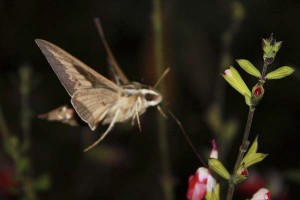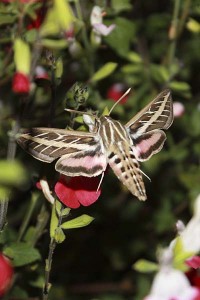Along with the flowers, spring brings its share of insects. I could do without the ants that are now beginning to explore the interior of the house, but the sphinx moths that started to appear in huge numbers last week are about as cool as any bug out there.
This is the white-lined sphinx moth, Hyles lineata. Although its main range is the American West and northern Mexico, the species can be found all over the US. (Check out the writeup at the terrific Butteryflies and Moths of North America site for more information.)
There are dozens of other sphinx moths, including the adults of the notorious tomato and tobacco hornworms, familiar to almost anyone who’s tried to grow a tomato plant. The caterpillars of the white-lined sphinxes, however, don’t seem to have the reputation for going on the same sort of sustained rampages against our vegetable gardens.
The way these large, muscular insects maneuver and hover over flowers as they feed reminds you of hummingbirds, and in fact they’re also called “hummingbird moths.” As with hummingbirds, they enjoy nectar-rich flowers, such as this Hot Lips sage. You can see these moths feeding during the daylight, but the populations really come out after the sun sets, forming quietly buzzing clouds at dusk or before the sun rises.
In no way do I consider myself an insect photographer. I quickly found out how frustrating it can be to photograph fast-moving moths with a camera that refuses to focus in the dark. These are the only two photos I kept out of a couple dozen tries.
 This second image is no stunner, but you can begin to make out the amazing long tongue that the moth uses to lap up the tasty nectar.
This second image is no stunner, but you can begin to make out the amazing long tongue that the moth uses to lap up the tasty nectar.
If you’re into insect photos done as well as anyone out there can do them, you should take a look at the work of Bob Parks. He was working at San Diego’s Museum of Natural History when I first met him ten or so years ago. I don’t know of anyone as passionate and devoted to bugs and photos of bugs. That passion shows in his technically outstanding and patiently rendered pictures. There’s a nice biographical writeup of him at the SDNHM site.

